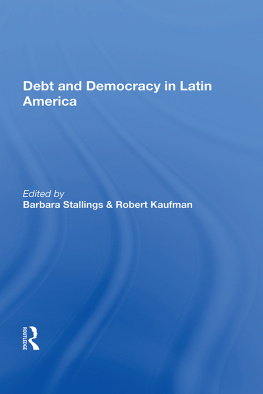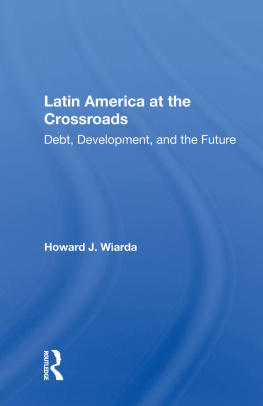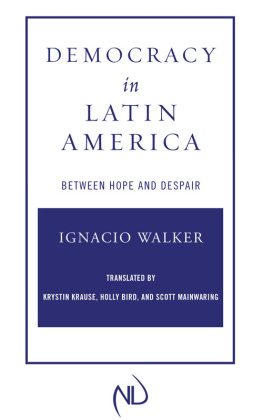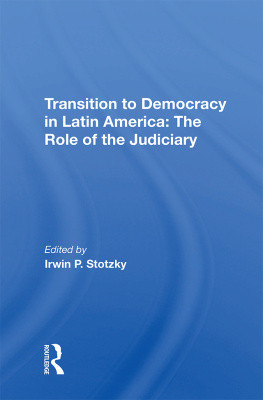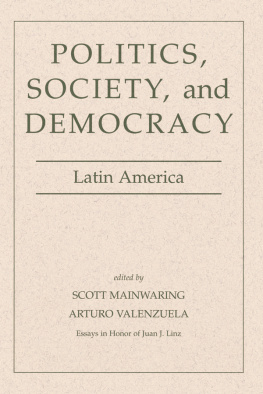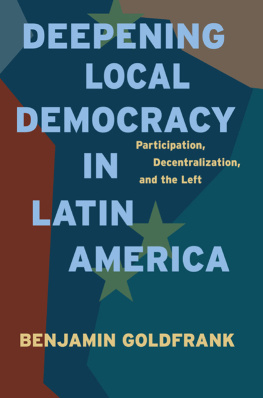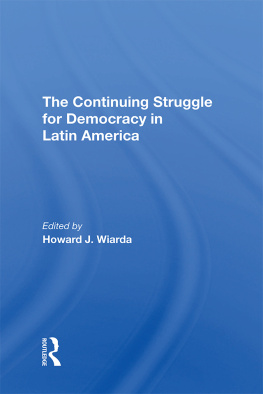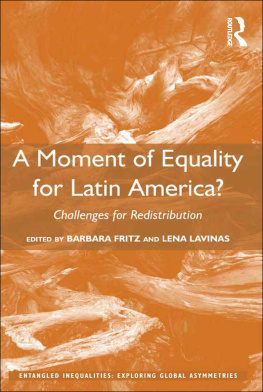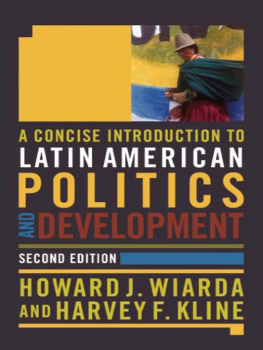Debt and Democracy in Latin America
First published 1989 by Westview Press
Published 2018 by Routledge
52 Vanderbilt Avenue, New York, NY 10017
2 Park Square, Milton Park, Abingdon, Oxon OX14 4RN
Routledge is an imprint of the Taylor & Francis Group, an informa business
Copyright 1989 by Taylor & Francis
All rights reserved. No part of this book may be reprinted or reproduced or utilised in any form or by any electronic, mechanical, or other means, now known or hereafter invented, including photocopying and recording, or in any information storage or retrieval system, without permission in writing fromthe publishers.
Notice:
Product or corporate names may be trademarks or registered trademarks, and are used only for identification and explanation without intent to infringe.
Library of Congress Cataloging-in-Publication Data
Debt and democracy in Latin America.
Includes index.
1. Debts. ExternalLatin America. 2. Latin America
Economic conditions1982-. 3. Latin America
Politics and government1980-. I. Stallings,
Barbara. II. Kaufman, Robert R.
HJ8514.5.D445 1989 336.3435098 8828009
ISBN 0-8133-7547-9
ISBN 0-8133-7548-7 (pbk.)
ISBN 13: 978-0-367-01449-0 (hbk)
Contents
, Barbara Stallings and Robert Kaufman
PART I
A POLITICAL-ECONOMIC OVERVIEW OF THE DEBT CRISIS
, Rudiger Dornbusch
, Jeffry Frieden
, Paul Drake
PART II
KEY ACTORS IN THE DEBT-DEMOCRACY DILEMMA
, Riordan Roett
, Sylvia Maxfield
, Ian Roxborough
PART III
CASE STUDIES OF DEBT AND DEMOCRACY
, Robert Kaufman
, Eul-Soo Pang
, Joan Nelson
, Carol Wise
, Barbara Stallings
PART IV
CONCLUSION
, Robert Kaufman and Barbara Stallings
Guide
Many people have helped at various stages in the preparation of this book. We would like to thank the contributors as well as the group of scholars who joined them early on to discuss some of the issues developed in the book. The latter group included Ren Cortzar, Kevin Middlebrook, Carlos Rico, Thomas Skidmore, and Torn Yanagihara. In addition, we are grateful to Eric Hershberg and Barbara Forrest of the Ibero-American Studies Program of the University of Wisconsin-Madison for their administrative assistance. We are also highly indebted to Jayni Edelstein and Kate Hibbard, who ably undertook the time-consuming tasks of typing and copy-editing the manuscripts.
Financial support was received from the Cyril B. Nave Bequest, the Hewlett Fund, the Anonymous Fund, and the University Lectures Committee (all of the University of Wisconsin-Madison) and from the Latin American Studies Center of the University of Wisconsin-Milwaukee.
Barbara Stallings
Robert Kaufman
Barbara Stallings and Robert Kaufman
Future historians trying to characterize Latin America during the 1980s are likely to focus on two main processes. In economic terms, virtually all Latin American countries were struggling with balance-of-payments deficits, high inflation, and stagnating production. These problems resulted from many adverse factors, both domestic and international, but the heavy burden of debt service payments certainly loomed large among them. On the political side, the 1980s saw many Latin American nations moving away from authoritarian regimes and toward democracyor at least toward greater openness and increased space for oppositional activities.
The link between these two processes is controversial. Did the economic crisis trigger the political change? Will the same crisis destabilize the very democracies it brought about? Will the type of regime influence the selection of policies to deal with the economic problems? Will it affect governments ability to implement chosen policies? It is not coincidence that these questions are controversial, for they are very difficult to answer. Nevertheless, they are sufficiently importantboth for the practical future of Latin America and for political-economic theorythat an attempt must be made. This book does just that. Through a series of general essays and case studies, it investigates the two-way relationship between debt and democracy in the 1980s. That is, we examine the evidence about how regime type influenced the choice of policy to deal with foreign creditors and related economic issues. We also reverse the question and look at how debt problems have affected the transition to, and the consolidation of, democratic political systems.
In most of our chapters, two sets of terms are central to the analysis. One is the distinction between democracy and authoritarianism. For our purposes, a regime can be considered democratic to the extent that incumbent governments must win and retain power through competitive elections, tolerate opposition challenges to their incumbency, and deal with relatively independent interest groups. Authoritarian regimes are those that do not permit competitive elections and restrict the space allowed to either oppositional or interest group activity. We also distinguish between orthodox and heterodox policy packages to deal with the economic problems confronting Latin America. The term orthodox refers to market-oriented approaches (often associated with the International Monetary Fund) that emphasize fiscal and monetary restraint, reduction in the size of the state sector, liberalization of trade restrictions, and collaboration with creditors. Although heterodox approaches do not reject all elements of this package, they generally advocate a more active state role in investment and economic regulation, are more willing to risk confrontation with creditors, and attach a higher priority to issues of distribution and employment.
The book is divided into four sections. The first provides an overview of the issues from economic, political, and historical perspectives. To begin, Rudiger Dombuschs chapter provides the essential background for a discussion of the debt issue. He explains the origins of the debt crisis, including both external and internal factors. Then he goes on to analyze the current problems, focusing on debtor countries need to grow, banks need to maintain their solvency, and creditor governments difficulties in reconciling the two. The outcome up until now has been a strategy of muddling through. Finally, Dombusch presents three alternative solutions to the crisis. One is lowering interest payments by capitalizing interest when payments exceed a certain level. A second is the establishment of a debt facility or agency that would buy part of the banks Third World debt at a discounted value and pass on the benefits to the debtors. Third, Dombusch explains his own preferred solution, which focuses on a responsible unilateral decision by debtor nations to reduce debt service in the context of a program to revive growth. The argument in favor of the third strategy is that both debtor and creditor countries will benefit in the long run.
The chapter by Jeffry Frieden turns to the political aspects and implications of the debt crisis. Focusing his analysis on the five largest debtorsArgentina, Brazil, Chile, Mexico, and VenezuelaFrieden identifies the economic interests of different social groups, both during the period of heavy borrowing in the 1970s and early 1980s and after lending ceased in 1982. One of his crucial distinctions is between groups that can easily move their assets and those whose assets are geographically fixed. These economic characteristics are linked to political activities once a crisis sets in. Frieden suggests that those with fixed assets are most likely to engage in political struggle to protect their property. The question then becomes whether they will try to pressure the government from inside or join the opposition. This choice is said to be determined by a groups political weight, its ties to the government, and the existence of a potent opposition whose goals are compatible with those of the group in question.

